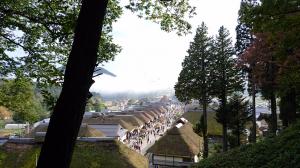| JET Study Tour Oct,2015 Member's Report11 | Name: Matthew Kissel(USA) |
|---|---|
Our tour of Aizu took us to a variety of places to learn about the history, present state and the future of Fukushima. Firstly, we saw various methods of radiation testing for food in Fukushima. This may be the most intriguing part of the whole tour for those people who don’t live in Fukushima, so I’ll talk a bit about that. All bags of rice exported from Fukushima are tested for radiation. We went to a facility where they do this testing. Each bag is slapped with a sticker that any consumer can scan and view the results of the test. Of course, any bag that exceeds the limits is disposed of. There are a few similar testing facilities throughout Fukushima. What surprised me most was actually nothing to do with the testing but how much rice they actually store in these warehouses.Rice is stored there for around a year (I think) and it is safe to store for up to two years. We then went to another facility where they test most other foods from Fukushima. I’ll admit a lot of the details but the only foods that still fail testing in Fukushima are wild plants (i.e. mostly mushrooms) and fish (from the wild). The wild mushrooms can be contaminated because of radiation hot spots, and farmed mushrooms tend to be safe because of the rigorous cleanup done all over farms in Fukushima. The coastal areas of Fukushima are only fished for testing purposes so it’s nothing we have to worry about eating. Another key focus of our trip was the future of Fukushima. Nuclear power plants provide a huge amount of energy and the prefecture now needs a way to replace it. We listened to a speech from a solar energy company, and learned how they had formed in the aftermath of the incident at Fukushima Daiichi and want to move towards clean and safe energies. A much larger source of power is a nearby geothermal plant. All of these are just pieces of the much larger puzzle for the future of power in Fukushima. Japan has a much older and more prominent cultural history than most of America. We got to experience this firsthand by visiting places like the traditional town of Ouchijuku (pictured) and the Enzoji shrine. We also got to paint Akabeko, a cow toy that is based off of a legendary cow that helped build the Enzoji temple. To get to our destinations we drove through many different parts of the gorgeous Aizu region. While some of the winding mountain roads might not be for those who get car sick it is definitely a beautiful place. I would be remiss if I didn’t mention the food we had during the trip. We at some delicious negi soba in Ouchijuki and also ate some amazing kitakata ramen. The ramen was probably the best ramen I ever had, unfortunately I remember the place where we got it. I’ll have to ask the trip’s organizers for next time I’m in the region. Although this trip was only a long weekend we covered a lot of different things and went many different places. At this point it seems like almost a blur. Since this trip was only a really only an introduction to a part of Fukushima prefecture I hope to learn much more about my new home in the future..
| |
| Back to tour's summary |








